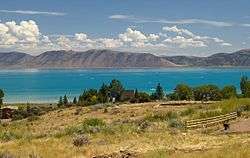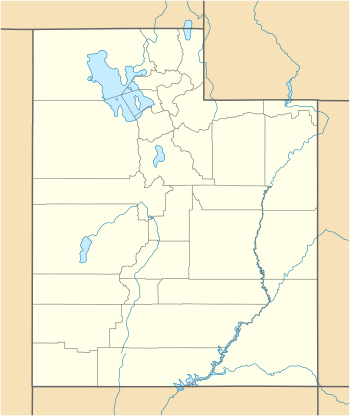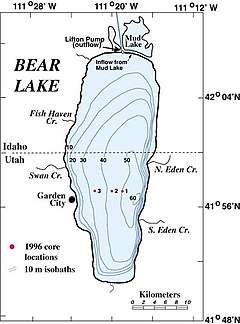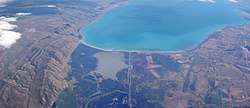Bear Lake (Idaho–Utah)
Bear Lake is a natural freshwater lake on the Idaho–Utah border in the Western United States. About 109 square miles (280 km2) in size, it is split about equally between the two states; its Utah portion comprises the second-largest natural freshwater lake in Utah, after Utah Lake.[1] The lake has been called the "Caribbean of the Rockies" for its unique turquoise-blue color, which is due to the refraction of calcium carbonate (limestone) deposits suspended in the lake.[2] Its water properties have led to the evolution of several unique species of fauna that occur only within the lake.[3] Bear Lake is over 250,000 years old.[4] It was formed by fault subsidence that continues today, slowly deepening the lake along the eastern side.[5]
| Bear Lake | |
|---|---|
 The lake's intense turquoise color is due to the presence of suspended limestone | |
 Bear Lake | |
 Bathymetric chart | |
| Location | Bear Lake County, Idaho Rich County, Utah, U.S. |
| Coordinates | 42°00′N 111°20′W |
| Primary inflows | Creeks: Fish Haven, North Eden, South Eden, Swan Creek, St. Charles |
| Primary outflows | Bear Lake Outlet Canal |
| Catchment area | 5,862,957 acres (23,727 km2) |
| Basin countries | United States |
| Max. length | 18.3 mi (29.5 km) |
| Max. width | 7.1 mi (11.4 km) |
| Surface area | 109 sq mi (280 km2) |
| Average depth | 94 ft (29 m) |
| Max. depth | 208 ft (63 m) |
| Water volume | 6,500,000 acre⋅ft (8.02 km3) |
| Residence time | 19.6 years |
| Shore length1 | 48 mi (77 km) |
| Surface elevation | 5,924 ft (1,806 m) |
| Settlements | Garden City, Utah, Laketown, Utah, Fish Haven, Idaho |
| 1 Shore length is not a well-defined measure. | |
Originally named "Black Bear Lake" by Donald McKenzie, an explorer for the North West Fur Company who explored the lake in 1819, the name was later shortened to Bear Lake.[6] The lake is a popular destination for tourists and sports enthusiasts, and the surrounding valley has gained a reputation for having high-quality raspberries.[7]
History
The first known inhabitants of the Bear Lake Valley were Shoshone tribes, but the area was known to many Native Americans. The first record of whites seeing the lake is from 1818 when French-Canadian trappers working for the North West Company followed the Bear River upstream to the valley.
The south end of the lake, in the area of modern-day Laketown, was the location of a rendezvous in the summer of 1827 and 1828. Mountain men, including Jedediah Smith and Jim Bridger, gathered at this location, along with trade goods suppliers, and American Indians from several different tribes. The mountain men and Indians sold their furs in exchange for various store goods and supplies, and several weeks were spent reveling in assorted amusements and liquor.[8][9]
Smith's arrival in June 1827 was especially historic, as it marked the completion of the first ever overland round-trip to California from the United States. As he wrote in his journal: "My arrival caused a considerable bustle in camp for myself and party had been given up as lost."[10]
Although the lake lies relatively near the Oregon Trail, which runs north and east of the lake, and was traveled by many pioneers between 1836 and the 1850s, it seems none of them went south enough to view the lake. It was not until 1863 that Mormon pioneers led by Charles C. Rich settled in the Bear Lake Valley, but they made an agreement with Native Americans which left most of the Utah portion of the valley in Indian possession. The Mormons gradually moved south and established the villages of Garden City, Pickelville, and Laketown, each along the lake's shore.
In later years, Bear Lake became a resort and recreation area, with many developers selling lake shore and mountain view lots. The beaches of Lakota and Ideal were given to private development in the 1970s, including the Blue Water and Sweetwater developments. The State of Utah bought the far southeast beach for use as a state park, and the state also operates a marina on the lake's west side.
Environmental concerns have arisen with the ongoing development of the area. The lake is diked on the Idaho side and downstream Bear River water users use it as a reservoir.
Features


Formed in a half graben valley straddling the Idaho-Utah border, the lake has an approximate area of 109 square miles (280 km2) and sits at an elevation of 5,924 feet (1,806 m) along the northeast side of the Wasatch Range and the east side of the Bear River Mountains.[11]
The lake and surrounding areas are a popular summer tourist destination. The lake has many marinas, beaches, and two tourist towns in Utah: Garden City and Laketown. It also has two state parks, each named Bear Lake State Park: one in Idaho, one in Utah. The Utah state park includes one-half-mile-long Rendezvous Beach at the south end of the lake, location of the 1827 and 1828 Rocky Mountain Rendezvous, and three-mile-long Cisco Beach on the east side, plus additional campground, marina, and boat ramp areas. The Idaho state park includes a north and an east unit, each with a one-mile-long beach. Bear Lake National Wildlife Refuge extends up from the north end of the lake.
Bear Lake has a high rate of endemism (native species not naturally found anywhere else). Several species evolved in the lake's waters, but after the diversion of the Bear River into the lake, many of these have gone extinct.[3] Remaining known endemic species of fish include the Bear Lake strain of the Bonneville cutthroat trout,[12] Bonneville cisco, Bonneville whitefish, Bear Lake whitefish, and Bear Lake sculpin.[3] There have been attempts to transplant these species to other areas without success,[13] with the exception of the Bear Lake Cutthroat Trout strain. This trout has flourished in other large bodies of cool water, including the Strawberry and Scofield reservoirs.
"The Bonneville cisco eat only small aquatic invertebrates or zooplankton. They are eaten by larger fish in the lake including whitefish, Bonneville Cutthroat Trout, and introduced lake trout."[13] Although several fish species have been introduced into the lake, native species have continued to thrive due to careful management.
Water from the lake is used for irrigation in the nearby Bear Valley in southeast Idaho, and for recreational fishing. The lake drains via the Bear River Outlet, completed in 1915 into the Bear River which eventually flows into the northeast portion of Great Salt Lake.
Raspberry Days festival
Bear Lake has become famous for the surrounding valley's crops of raspberries and for the annual Raspberry Days festival held in Garden City to celebrate the harvest of raspberries, generally during the first week of August. This event is said to bring thousands of people from all over the world and features rodeos, parades, fireworks, dances, a craft fair, "Miss Berry Princess contest", raspberry recipe cookoff, a talent show, fun run and concerts.[7] A majority of the original Bear Lake Raspberry plants were infected with a virus during 2001, with fewer than five acres surviving. This epidemic resulted in most of the large berry business in Garden City being wiped out. Some acreages were replaced by virus resistant plants and although some varieties of raspberries are resilient to the virus, none can produce fruit as succulent and sweet as the traditional plants.[14] The raspberry business has since been redeveloped and the world-famous raspberries are again thriving in the valley. Most of the raspberry farming has redeveloped in the southern end of the valley.
See also
References
- Notes
- Bear Lake history & facts. Utah Division of Wildlife Resources.
- Bear Lake State Park. Utah.com
- Bear Lake Geological Background: Endemism Archived May 22, 2006, at the Wayback Machine. U.S. Geological Survey.
- "See Rosenbaum and Kaufman, 2009". Archived from the original on 2012-05-31. Retrieved 2009-04-17.
- Bear Lake Geological Background: Tectonism Archived May 22, 2006, at the Wayback Machine U.S. Geological Survey.
- Bear Lake State Park: In Depth Archived September 24, 2006, at the Wayback Machine. Utah State Parks and Recreation.
- Bear Lake Raspberry Days. Utah Outdoor Activities.
- "Mountain Men and Life in the Rocky: Rendezvous".
- Eddins, Ned O. "Mountain Man Rendezvous Sites". Archived from the original on 2012-11-15.
- Smith, Jedediah S., [Harrison G. Rogers], and George R. Brooks (ed.). The Southwest Expedition of Jedediah S. Smith: His Personal Account of the Journey to California, 1826–1827, p. 197. Lincoln and London, University of Nebraska Press, [1977] 1989. ISBN 978-0-8032-9197-3
- Bear Lake Archived 2006-07-24 at the Wayback Machine. Utah Division of Water Quality.
- "Oncorhynchus clarkii utah (Suckley, 1874) (Bonneville Cutthroat Trout)".
- "Bonneville Cisco". Archived from the original on 2012-10-31.
- Deseret Digital Media Bear Lake Raspberry Days. The Logan Library.
- Sources
- Peterson, F. Ross (1994), "Bear Lake", in Powell, Allan Kent (ed.), Utah History Encyclopedia, Salt Lake City, Utah: University of Utah Press, ISBN 0874804256, OCLC 30473917
External links
| Wikimedia Commons has media related to Bear Lake (Idaho–Utah). |